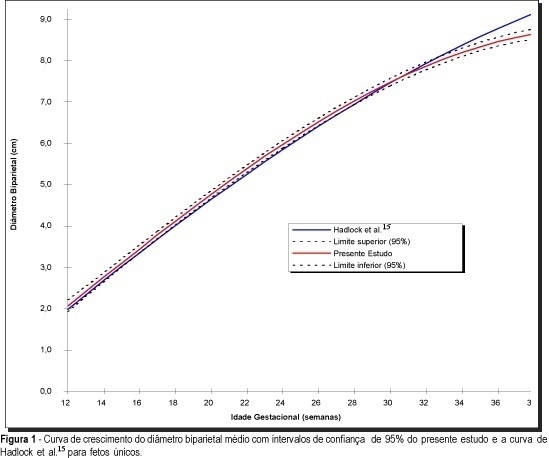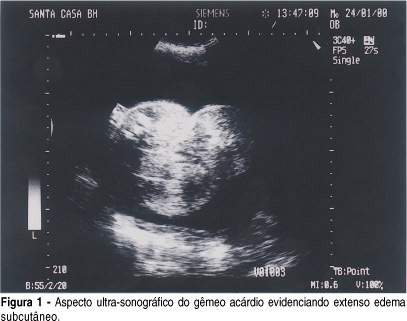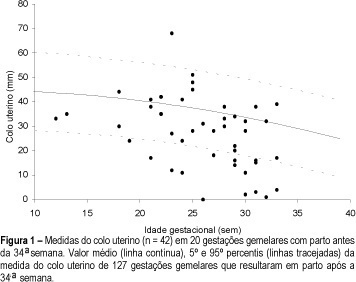Summary
Revista Brasileira de Ginecologia e Obstetrícia. 2020;42(1):61-64
Premature delivery often complicates multifetal pregnancies, placing neonates at risk of seriousmorbidity andmortality. In select cases, pretermbirth of one sibling may not require delivery of the remaining fetus(es), which may remain in utero for a delayedinterval delivery, consequently improving neonatalmorbidity andmortality. Currently, there is no consensus on the best protocol for the optimalmanagement of these cases. We report one case of delayed-interval delivery of a dichorionic pregnancy assisted in our center. In this case, prophylactic cerclage, tocolytic therapy and administration of broad-spectrum prophylactic antibiotics enabled delivery at 37 weeks, corresponding to 154 days of latency, which is, to our knowledge, the longest interval described in the literature. The attempt to defer the delivery of the second fetus in peri-viability is an option that should be offered to parents after counseling, providing that the clinical criteria of eligibility are fulfilled. The correct selection of candidates, combined with the correct performance of procedures, as well as fetal and maternal monitoring and early identification of complications increase the probability of success of this type of delivery.
Summary
Revista Brasileira de Ginecologia e Obstetrícia. 1998;20(5):261-264
DOI 10.1590/S0100-72031998000500005
The disadvantages of the second twin in respect of his birth conditions are of great concern. In this study we have reviewed 90 twin births occurred at the Maternidade da Encruzilhada (CISAM) in Recife, from January/92 to December/93, in order to compare perinatal variables between the first and second twin. Fetal presentation, way of delivery, birth weight, Apgar of the 1st and 5th minutes, occurrence of perinatal complications such as hyaline membrane syndrome, transitory tachypnea, and neonatal infection and, finally, the prognosis of each of the twins were evaluated. There was no statistical difference between the incidence of non-vertex presentation, cesarean section, low birth weight, Apgar < 7 in the 1st and 5th minutes and neonatal complication cited above. There was also no difference in perinatal mortality between the first and the second twin. Our results suggest a similar birth condition for both twins of a same pregnancy, therefore, the same perinatal care must be provided for each one.
Summary
Revista Brasileira de Ginecologia e Obstetrícia. 1998;20(7):415-419
DOI 10.1590/S0100-72031998000700008
Twin pregnancy in which a normal fetus and a complete mole develop at the same time is a rare event. Clinical complications and malignancy are frequent in this type of disease.This report is about a case of a late diagnosis due to the presence of the fetus. The diagnosis was made when the pregnancy was interrupted and then confirmed by histopathological study and flow cytometry. The pregnancy was terminated transpelvically due to massive uterine hemorrhage. The post-molar follow-up showed the persistence of high levels of bhCG. The patient's complete recovery was achieved after the administration of methotrexate. The diagnosis, natural history, and procedures for this rare disease are discussed in view of this case.

Summary
Revista Brasileira de Ginecologia e Obstetrícia. 1999;21(4):223-226
DOI 10.1590/S0100-72031999000400007
Purpose: to evaluate retrospectively the obstetrical and perinatal aspects of multiple pregnancies with the death of one fetus. Methods: a retrospective study on 26 pregnant women with multiple pregnancies and death of one twin. A conservative approach was followed and the patients were followed-up clinically with blood clotting tests. Results: in 50% of the cases fetal death occurred between 20 and 32 weeks of pregnancy. The time between death and resolution of pregnancy ranged from 6 to 148 h. Death of the other twin occurred in two cases. In 15 cases, the surviving twin had a good course, with two of them presenting slight neurological sequelae. In the other nine cases the other twin died after birth. No pregnant woman developed coagulation disorders.
Summary
Revista Brasileira de Ginecologia e Obstetrícia. 1999;21(10):569-576
DOI 10.1590/S0100-72031999001000002
Purpose: to estimate growth curves and tables of average biparietal diameter and average head circumference of twin gestations and to compare them with published growth curves for singletons and twins. Methods: growth curves and tables of average biparietal diameter and average head circumference were obtained from sonographic examinations of 34 patients with twin gestations without maternal and fetal complications. Sonographic examinations were performed each 2 or 3 weeks by a single observer. The parameters were compared with existing growth curves for singletons and twins. Results: curves and tables of biparietal diameter and head circumference in relation to gestational age were obtained. The study revealed difference in growth pattern mainly regarding the 3rd trimester in relation to singletons (Hadlock et al.15). The difference between the average values were 6 mm (biparietal diameter) and 2.0 cm (head circumference) at the 39th week of gestation. Also, some differences were observed relative to the twin studies. Conclusion: this study revealed that growth curves for average biparietal diameter and average head circumference of singletons are not appropriate to determine gestational age in twin gestations of the studiced population principally at the 3rd trimester

Summary
Revista Brasileira de Ginecologia e Obstetrícia. 2004;26(6):489-494
DOI 10.1590/S0100-72032004000600011
Twin pregnancy with an acardiac twin is a rare event characterized by the presence of a placentary arterial anastomosis between the pump twin, morfologically normal, and the acardiac twin, causing a reverse circulation in one of the twins. The major complications are associated with cardiac failure in the normal twin, which is due to circulatory overload and prematurity. Many therapeutic options have been proposed, but there is no consensus about which one is the best therapy. However, intrafetal ablation of the umbilical artery of the acardiac fetus proved to be an inexpensive method that is easy to perform and highly efficient in controlling circulatory overload. We presented two cases of intra-fetal ablation and good evolution. A triplet pregnancy in which the intra-fetal ablation was done in a 29-week-old fetus that evolved to premature delivery of a healthy baby, and a twin pregnancy in which intra-fetal ablation was done in a 31-week-old fetus that evolved to premature rupture of membranes and the premature delivery of a healthy baby.

Summary
Revista Brasileira de Ginecologia e Obstetrícia. 2003;25(10):739-744
DOI 10.1590/S0100-72032003001000007
PURPOSE: to verify the contribution of maternal age, parity, twin pregnancy, hypertensive syndrome, and premature rupture of membranes as risk factors for cesarean section. METHODS: after approval by the Ethics in Research Committee of the "Maternidade Professor Monteiro de Morais" - Recife, PE - Brazil, for a case control study, the authors analyzed data from 3919 pregnant women, without two or more prior cesarean sections, who gave birth to alive newborns with gestational age equal to or more than 28 weeks, weighing at least 1,000 g, on cephalic presentation, from September 1, 1999 to August 31, 2000. The case group included women submitted to cesarean section and the control group included women submitted to vaginal delivery. With the data collected from obstetric and neonatal reports, the authors performed multivariate analysis by logistic regression to determine a mathematical equation that associates cesarean probability due to more than one independent variable acting as risk factor, determining odds ratio with a confidence interval of 95% (95% CI), for the variables: maternal age, parity, twin pregnancy, hypertensive syndrome, and premature rupture of membranes. RESULTS: the chances for cesarean section significantly increased 8.3 times in twin pregnancy (OR = 8.3; 95% CI: 3.7-19.1), 3.4 in hypertensive syndrome (OR = 3.4; 95% CI: 2.9-4.0), 1.9 in primiparity (OR = 1.9; 95% CI: 1.8-2.0), 1.5 in maternal age over 34 years (OR = 1.5; 95% CI: 1.2-1.8), and 1.2 in the presence of premature rupture of membranes (OR = 1.2; 95 %CI: 1.0-1.4). CONCLUSIONS: the risk for cesarean section was greater in the presence of premature rupture of membranes, maternal age greater than 34 years, primiparity, hypertensive syndrome, and twin pregnancy.
Summary
Revista Brasileira de Ginecologia e Obstetrícia. 2002;24(6):377-381
DOI 10.1590/S0100-72032002000600004
Purpose: to establish a reference range for cervical length measurement throughout gestation in twin pregnancies and to correlate cervical length with gestational age at delivery. Methods: retrospective analysis of prospectively collected data between 1994 and 2000, involving 149 twin pregnancies undergoing transvaginal ultrasound examination every four weeks for measurement of cervical length. Results: one hundred and twenty-seven women (85.2%) delivered after 34 weeks, 20 (13.4%) between 24 and 33 weeks and two pregnancies resulted in fetal loss before 24 weeks. The mean gestational age at delivery was 36.3 weeks. A total of 497 ultrasound examinations with cervical length measurement were performed in 127 patients with twin pregnancies who delivered after 34 weeks (mean = 4 examinations per patient). All scans were carried out between 9 and 39 weeks (mean = 29.4 weeks). There was an inverse correlation between cervical length measurement and gestational age at the scan in twin pregnancies (r=-0.44; p < 0.0001). The mean value was 44 mm at 10 weeks and 28 mm at 36 weeks. The corresponding fifth percentile values of these gestations were 28 mm and 12 mm, respectively. Cervical length measurement changes were more pronounced in the second half of the pregnancy (Kruskal-Wallis test, p=0.0006). Mean cervical length measurement and 90% prediction interval values were established throughout gestation by regression analysis. Twenty-six cases delivered before 34 weeks, nine of these cases (34.6%) had at least one cervical length measurement below the 5th percentile. Conclusions: cervical length shortens gradually throughout gestation in twin pregnancies but changes are more significant in the second half of the pregnancy. Approximately one-third of the pregnancies that delivered before 34 weeks had at least one cervical length measurement below the 5th percentile for the gestational age.
